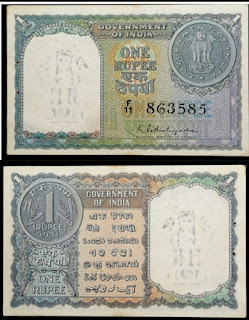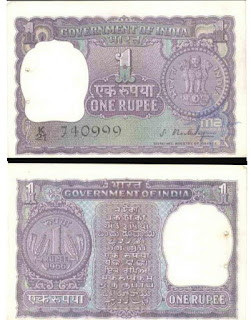The word "rupee" comes from a Sanskrit word "rupya" which means "wrought silver "and maybe also something stamped with an image or a coin. As an adjective it means 'shapely', with a more specific meaning of 'stamped, impressed, whence 'coin'. It is derived from the noun rupa "shape, likeness, image". Arthashastra, written by Chanakya, the prime minister of Chandragupta Maurya (340-290 BC), mentions silver coins as rupyarupa, other types including gold coins as suvarnarupa, copper coins as tamrarupa and lead coins as sisarupa.
The current rupee owes its origin to 'rupiya' a silver coin issued by Sher Shah Suri in 1540-45. The rupee (coin) remained in use through the Mughal period as well as in British India. The earliest issues of paper rupees include the Bank of Hindostan 1770-1832, the General Bank of Bengal and Bihar 1773-75, and the Bengal Bank 1784-91.
During the World War 1, the prices of silver surged. This led to the introduction of the 'One Rupee' note on November 30, 1917, the first note had the signatures of three British finance secretaries, MMS Gubbay, AC McWatters and H Denning, these notes were issued as promissory notes and were printed in England. They were issued in the form of a booklet containing 25 notes. They were discontinued on 1st January 1926.
In 1917-18, the Nizam of Hyderabad was given the privilege to print and issue their own currency.
The second note was issued on 24th July 1940. The 1940 Ordinance said that the notes were issued as Government of India notes with the status of a one-rupee coin. These notes were however, printed in England in 1935. They had a photo of King George V and a photo of the prevalent silver coin on it.
The size of this note was 12 x 17 cm. These notes were issued in booklets of 25 notes each as in the 1917 issue. The cover of the booklet was grey green with the royal insignia of G.R.I. and the crown in the center.
One rupee coin of King George V on the front with eight languages and dated 1935 on the reverse. However, with the death of King George in early 1936 the notes were not issued. With the outbreak of World War II, in 1939 causing shortage of precious metal, these were issued in 1940. They were the only banknotes of this denomination to have a serial number on the reverse.
The third issue were the George VI design one-rupee notes of 1940. These notes were very popular with the public. With the 1935 issue not released until 1940, these were issued in 1944.
King George VI on a coin of one rupee with the year 1940 on the reverse. The language panel was moved to the reverse, with the Devanagari script changed to Hindi. These notes continued to be in circulation even after India became independent in 1947 and was legal tender till, they were withdrawn in 1957.
Japan invaded Burma in 1942 and the occupation lasted till 1945. The Japanese issued their own currency in lieu of the Reserve Bank of India notes.
Burma and Pakistan overprints, 1945 and 1948 respectively.
King George VI's one-rupee notes were overprinted for use of Burma 1945 and withdrawn in 1950.
Apart from British India, Hyderabad, Kashmir, Indo French and Indo Portuguese too issued their one-rupee notes.
After Independence of India in 1947, the design originally sought to replace the King's portrait was suggested to be a portrait of Mahatma Gandhi as depicted in the specimen pattern note.
However, post-independence, the first one-rupee notes were issued during the tenure of the Secretary, Ministry of Finance, Mr. KRK Menon in 1949. The King's portrait was replaced by the National Emblem, the Ashoka Pillar and the reverse had a floral motif.
The Indian rupee was an official currency of other countries including Aden,Oman, Dubai, Kuwait, Bahrain, Qatar and the Trucial States, Kenya, Tanganyika, Uganda, the Seychelles and Mauritius. The Indian government introduced the Gulf rupee as a replacement for circulation outside the country in 1959. After India devalued the rupee on 6th June 1966, those countries still using it, Oman, Qatar and the Trucial States (became United Arab Emirates in 1971), replaced the gulf rupee with their own currencies. Kuwait and Bahrain had done so in 1961.
In 1951, the change was the addition of the obverse and reverse of the one-rupee coin and the National Emblem.
In 1957, below the signatures of the Principal Secretary, ' Ministry Finance' was added. The design on the note was changed too and the note included 'sau naye paise' coin in place of the earlier 'One Rupee' coin on the reverse.
In 1966 a new design emerged under Mr S Bhoothalngam and the size of the note was also reduced. It included 13 regional languages in the panel on the reverse.
In 1969, when Mahatma Gandhi completed hundred years of his birth, a commemorate coin was issued on the one rupee note, for the first time in India. The rest of the design, colour and style of the note were the same as in the previous issues.
In 1976, the style and the font of the serial were changed, and the prefix 'J' was discontinued under the Finance Secretary, Mr. Manmohan Singh.
In 1981, the reverse of the note was changed to offshore oil rig ' Sagar Samrat' design and the Hindi signature was introduced for the first time with the English.
In 1983, the design was again changed on obverse and reverse.
The design remained unchanged and was continued till 1994. Due to high cost of its production, the one-rupee note was discontinued and was finally reissued in 2015, with few changes. The number of regional languages increased to 15 in the language panel on the reverse.
The star series, with a changed design, change in colour (pink and green) and fifteen languages on the panel. While the telescopic series 'Secretary, Ministry of Finance was introduced on one rupee note in 2017.
The one rupee note has retained many of its unique distinctions over the last more than a century, including being called a "coin" in legal speak. It is issued by the Government of India and not the Reserve Bank. Every one-rupee note is signed by the Finance Secretary of India and not the Governor RBI.

























No comments:
Post a Comment
Any inputs or feedback is welcome!